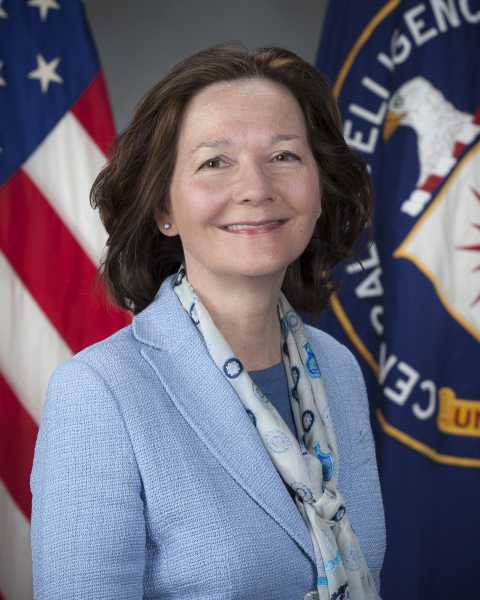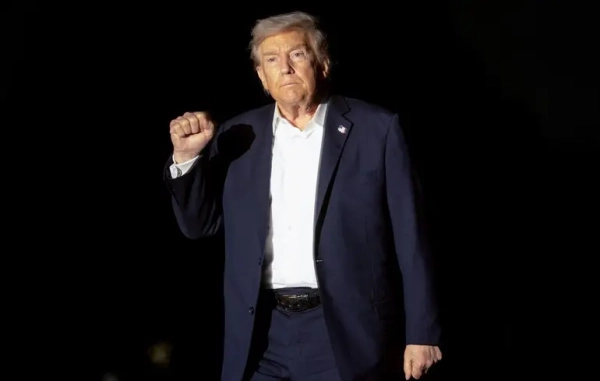
Gina Haspel, President Donald Trump’s controversial pick to be the next CIA director, has officially been confirmed by the Senate in a 54-45 vote.
Despite facing a tough confirmation hearing before the Senate Intelligence Committee last week over her role in a Bush-era torture program, Haspel apparently convinced enough senators that she was the right woman for the job.
In fact, Haspel, 61, is the first woman ever to head the spy agency. She’s a 33-year veteran of the clandestine service — the branch of the CIA formally known as the Directorate of Operations that does all the secret undercover spy work most people picture when they think of the CIA.
Because most of her work was done undercover, the American public — and the senators who have to vote on her nomination — knew very little about her before Trump picked her to lead the agency after Mike Pompeo.
But the few things we did know were disturbing.
We knew Haspel oversaw one of the Bush administration’s most notorious “black sites” — secret prisons the CIA set up around the world to hold and torture suspected terrorists away from the prying eyes of lawyers, human rights groups, and the American public — in Thailand.
And we knew, based on recently released internal CIA documents, that she was directly involved in the destruction of nearly 100 videotapes documenting the CIA’s brutal interrogation and torture of two prisoners, Abu Zubaydah and Abd al-Rahim al-Nashiri, at that black site.
CIA operatives there subjected Zubaydah and al-Nashiri to waterboarding, “walling” (slamming them repeatedly into walls), sleep deprivation, nudity, and being held in confined spaces (including a wooden box the size of a coffin) for hours at a time.
Haspel didn’t officially take charge of the black site until after Zubaydah’s interrogation was over. But she was in charge during al-Nashiri’s interrogation.
All of which helps explain why many observers, including some senior White House officials, thought she might be defeated. CNN reported that some national security officials and even some Republicans had begun coming up with a backup plan if Haspel wasn’t confirmed.
With Haspel’s nomination facing increasingly long odds, the White House — and President Trump himself — launched a public relations blitz defending Haspel and blaming Democrats for trying to block her nomination:
Both Democrats and Republicans had voiced concerns about Haspel. Republican Sen. John McCain, who was tortured as a prisoner of war in Vietnam, wrote a letter to Haspel demanding she explain in detail her exact role in the CIA’s “enhanced interrogation” program.
Haspel did address those questions at her confirmation hearing. She told senators that she doesn’t believe torture works and vowed that “under my leadership, CIA will not restart such a detention and interrogation program.”
In a follow-up letter to Virginia Sen. Mark Warner, the top Democrat on the Senate Intelligence Committee, Haspel went even further, stating that the interrogation program “is not one the CIA should have undertaken.”
But McCain wasn’t convinced: After the hearing, he tweeted that “her refusal to acknowledge torture’s immorality” was “disqualifying.”
However, McCain, who has been away for several weeks undergoing treatment for brain cancer, didn’t end up casting a vote. And many others who had been skeptical of Haspel — including Warner and several other Democrats — did vote to confirm her.
Which means Gina Haspel, who played a central role in one of the darkest periods of American history, is now our new CIA director.
If you ask the CIA, Haspel is an American hero, not a torturer
Before Trump announced Haspel’s nomination on March 13, very few people outside of the intelligence community had ever heard her name. She’s not on social media or LinkedIn. She doesn’t give public speeches.
That’s no accident. A clandestine service officer’s work is done in the shadows. If you know an operative’s (real) name and face, something has gone horribly wrong.
But once Haspel was nominated to be the next director of the CIA, the agency begrudgingly decided to release a very limited amount of biographical information about the operative, who is currently the spy agency’s deputy director.
In an online article with the cheery title “Get to Know Our Deputy Director,” the CIA shared details about Haspel’s background and career, including that she’s originally from Kentucky and that she has a 5-foot-tall poster of Johnny Cash in her office. She is not married and has no children.
“For the past three decades,” the article read, Haspel has “quietly devoted herself to serving on the front lines of the Agency’s mission.”
The agency also released a declassified timeline of her career that offers a bare-bones sketch of her trajectory from a young case officer in Africa in the late 1980s to the chief of station for the “Eurasia Division” in the 1990s to her position as the first female deputy director of the CIA in 2017.
As David Ignatius of the Washington Post pointed out, her time working in the Eurasia Division in particular gave her up-close experience working against one of the CIA’s toughest foreign adversaries: Russia.
“She has a Ph.D. in the FSB, SVR and GRU,” Dan Hoffman, a former Moscow CIA station chief who worked closely with Haspel, told Ignatius, referring to the initials of the three main Russian intelligence agencies.
But, critically, the CIA timeline explicitly stated that it “does not cover more than 30 short-term, temporary duty (‘TDY’) assignments over the course of her career.”
Assignments like running a CIA black site in Thailand, for instance.
During the time period in question, 2001 to 2004, the CIA timeline merely said Haspel was a deputy group chief and then a senior-level supervisor in the agency’s Counterterrorism Center. However, mostly thanks to journalists, we actually know a lot more about where Haspel was during those years and what she was doing. It’s ugly, and possibly illegal.
Haspel ran a notorious black site where detainees were tortured
The New York Times, ProPublica, the New Yorker, and others have all independently reported that Haspel oversaw a secret black site prison in Thailand, code-named “Cat’s Eye.” Other CIA black sites are said to have existed in Poland, Romania, Lithuania, Kosovo, and elsewhere.
Abu Zubaydah was the first prisoner interrogated at the Thailand black site. The CIA suspected him of being a high-level al-Qaeda operative involved in the 9/11 attacks (even though it later turned out that not only was he not a high-level operative, he wasn’t even a member of al-Qaeda). He’s been described as the Bush administration’s — and the CIA’s — “guinea pig” for the “enhanced interrogation techniques” that the Obama administration would later call torture.
Zubaydah was waterboarded 83 times in August 2002 alone, according to a 2005 memo from then-Deputy Assistant Attorney General Steven Bradbury to John Rizzo, who was acting general counsel for the CIA at the time.
He was also slammed repeatedly into walls, sometimes 20 to 30 times consecutively; put into painful stress positions; forced to endure extended sleep deprivation (more than 96 hours), during which he had to wear an adult diaper; kept naked for extended periods; and kept in confined spaces like a wooden box the size of a coffin for hours at a time.
Zubaydah’s brutal interrogations were also videotaped (more on this in a minute).
According to the New York Times, Haspel took over control of the Thailand black site in late October 2002. That would put her there after the torture of Zubaydah took place (though some reports still put her at the scene during his interrogation).
But according to numerous credible reports, she was in charge during the November 2002 torture of Abd al-Rahim al-Nashiri.
Al-Nashiri was believed to be an al-Qaeda “terrorist operations planner” who was “intimately involved” in planning the bombings of the US embassies in Kenya and Tanzania in 1998 and the USS Cole in 2000. He was captured in the United Arab Emirates in mid-October 2002 and was eventually moved to the black site in Thailand.
According to the 2014 Senate Intelligence Committee Torture Report, “al-Nashiri was interrogated using the CIA’s enhanced interrogation techniques, including being subjected to the waterboard at least three times” while he was at the Thailand black site (which the report refers to as “DETENTION SITE GREEN”).
The Thailand black site was shut down shortly after, in December 2002, after a US newspaper discovered that Zubaydah was being held in Thailand. Zubaydah and al-Nashiri were transferred to a different black site (this one in Poland), where al-Nashiri’s interrogation continued. (Both Zubaydah and al-Nashiri are still in US custody today at the US prison at Guantanamo Bay, Cuba.)
But although the Thailand black site was officially closed, the videotapes documenting what the CIA did there remained.
Haspel helped destroy video evidence of CIA torture
In 2004, journalists uncovered gruesome photos documenting the torture and abuse of detainees at Iraq’s Abu Ghraib prison by US soldiers. The photos shocked the world — and scared senior officials at the CIA, who feared they’d face a similar backlash if the tapes of Abu Zubaydah’s interrogation ever got out.
John Rizzo, the former CIA acting general counsel for the CIA, described what happened in a 2015 interview with Frontline:
Rizzo said he’d actually gotten requests from CIA officials for legal permission to destroy the tapes as early as October 2002 — around the time Haspel was about to take over command of the Thailand black site — but he and other senior Bush administration lawyers repeatedly denied the requests.
Then, in November 2005, Rizzo got a cable out of the blue saying: “Pursuant to headquarters’ directions, the videotapes have been destroyed.”
It turns out that a few days before, a cable had gone out from CIA headquarters directing black site managers to destroy the tapes.
The person who issued that cable was Gina Haspel.
Why most of the CIA rank and file still support Gina Haspel
Haspel was serving as chief of staff to Jose Rodriguez, the director of operations overseeing the CIA’s entire clandestine branch, when she issued the cable. Her supporters argue she was just following orders and had no part in the decision to order the tapes’ destruction. That decision was made by Rodriguez alone — something he’s also stated publicly before.
Indeed, a recently declassified internal CIA “disciplinary review” conducted in 2011 backs up this account. The review, conducted by former CIA Deputy Director Michael Morell, “found no fault with the performance of Ms. Haspel.”
“She drafted the cable on the direct orders of Mr. Rodriguez,” the review stated. “[S]he did not release that cable. It was not her decision to destroy the tapes; it was Mr. Rodriguez.”
In other words, Haspel was just following orders.
That sentiment — that Haspel was just a good soldier following orders during one of the toughest, most controversial periods in CIA history — may help explain why so many former CIA officials, including officials appointed by President Obama, came out in support of her nomination.
A group of 53 former top intelligence officials, including three former directors of national intelligence and six former CIA directors, sent a letter to the Senate Intelligence Committee expressing their “strong support” for Haspel to become the next CIA director.
“Ms Haspel’s qualifications to be CIA Director match or exceed those of most candidates put forward in the Agency’s 70-year history,” the letter said.
As Vox’s Alex Ward noted, the White House also released a full-throated defense of Haspel earlier in May, calling her “the Right Person to Lead the CIA.” The fact sheet contained laudatory statements by former US intelligence leaders, including John Brennan and James Clapper, both of whom Trump routinely attacks because of their service in the Obama administration.
Clapper, the director of national intelligence under President Barack Obama, said he “think[s] the world of Gina; she is capable, smart, very experienced, well respected by the Agency rank and file, and a great person,” per the fact sheet. Brennan, Obama’s CIA director, said Haspel “has the experience — the breadth and depth — on intelligence issues.”
It seems the White House’s media blitz worked.
Sourse: vox.com






